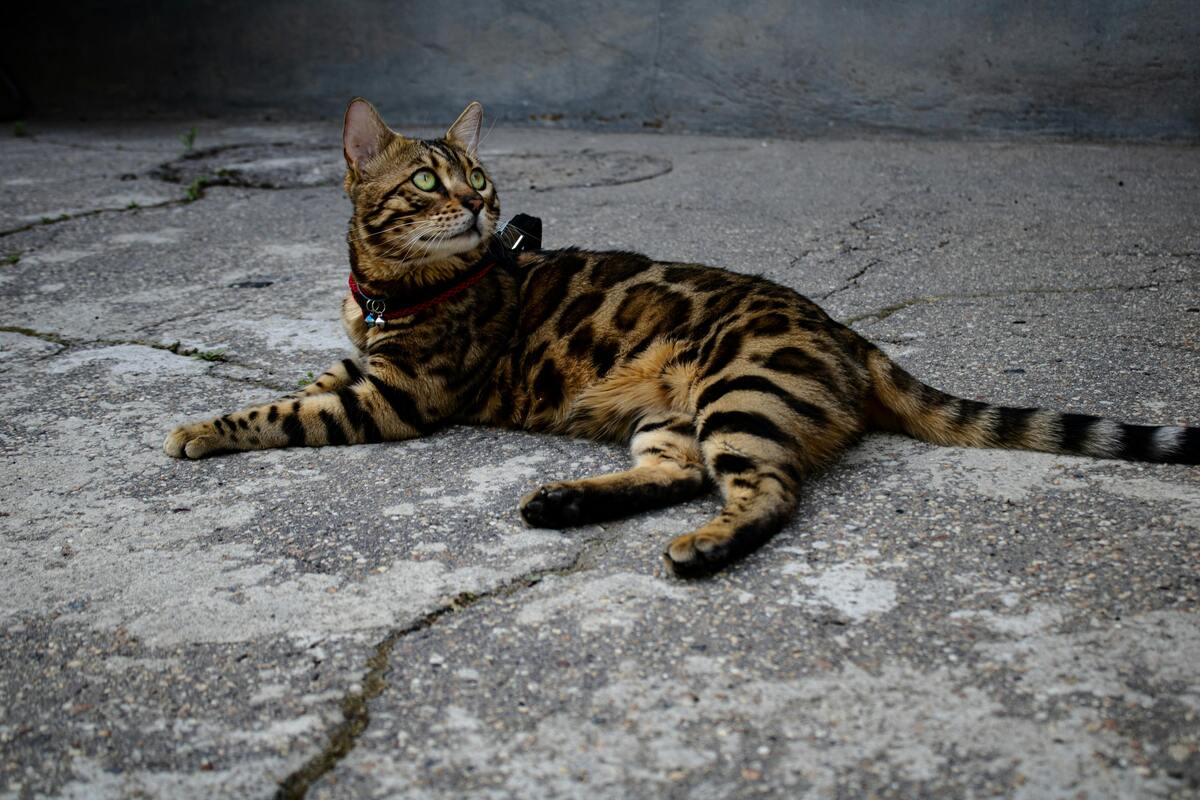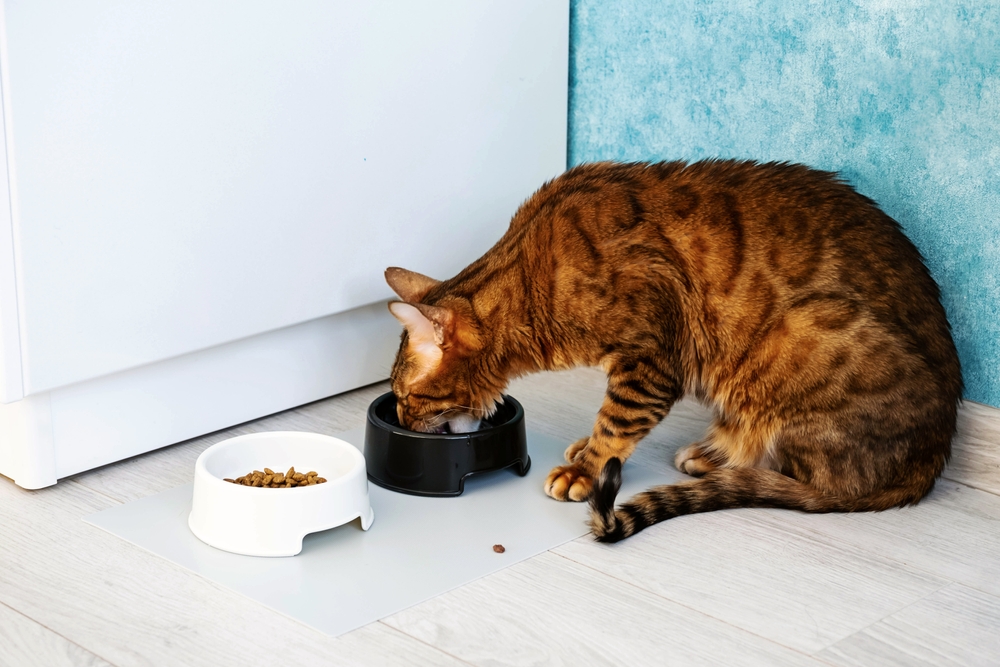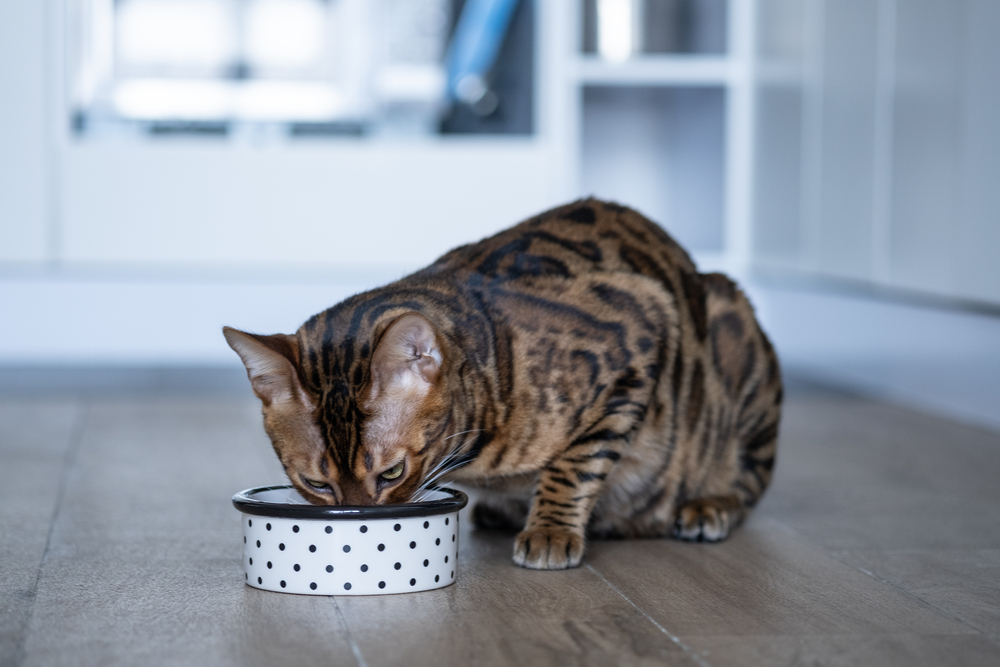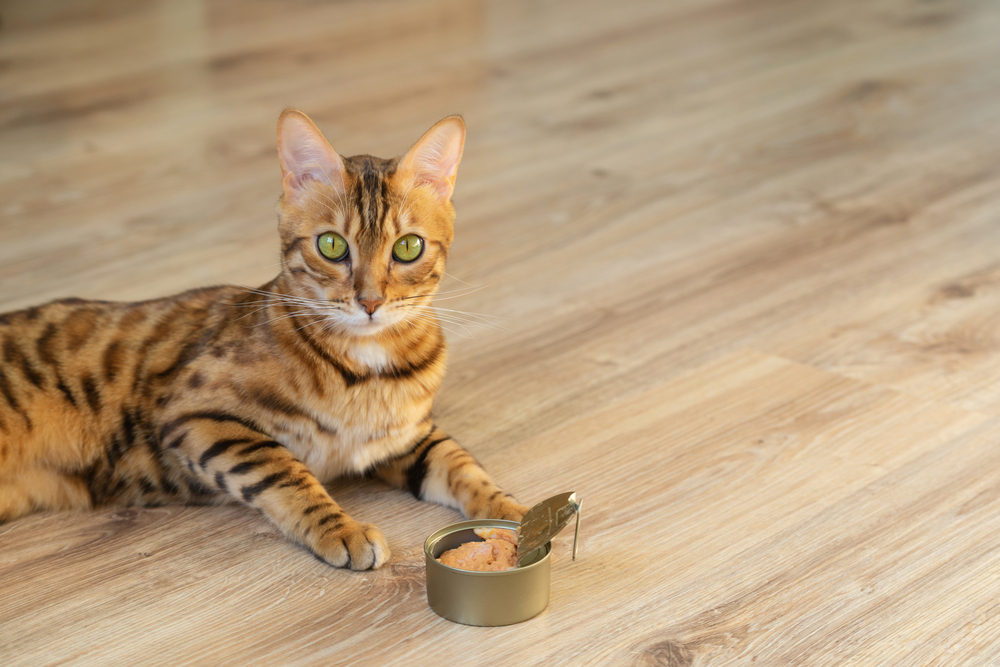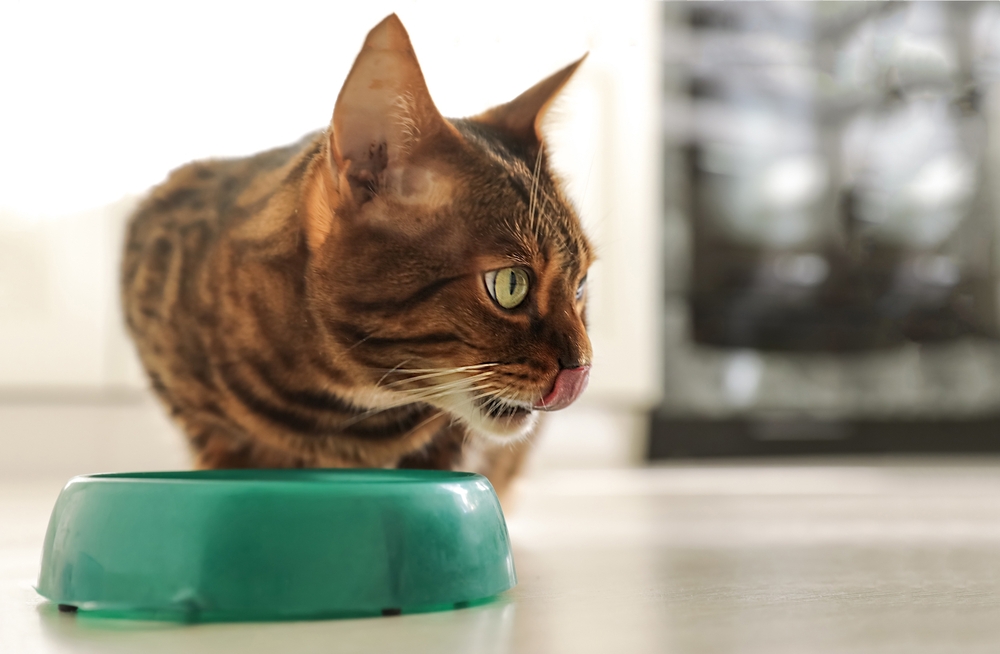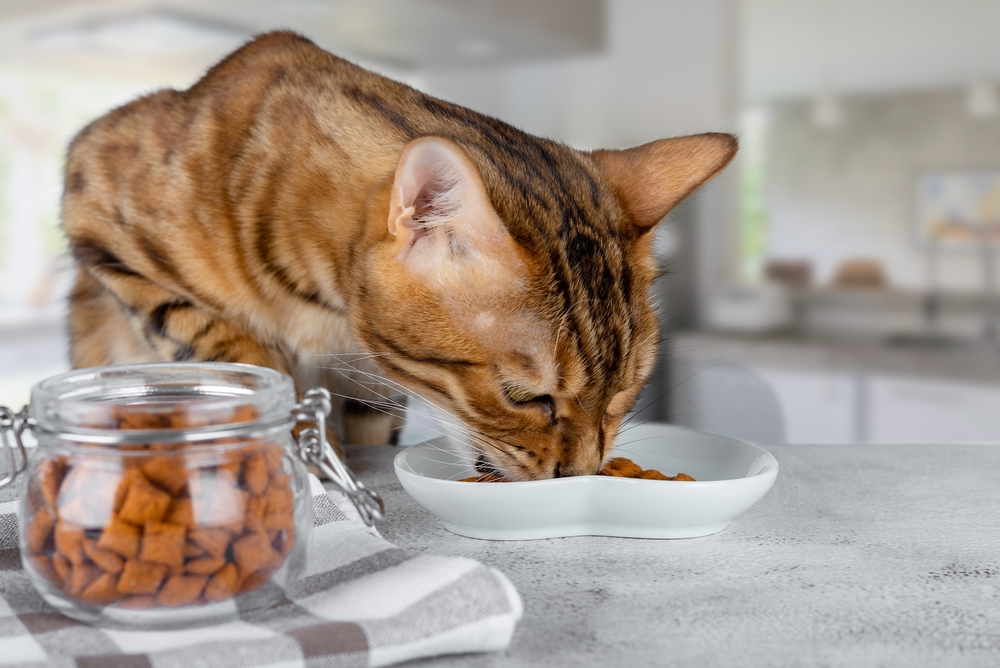📖 Table of Content:
With spots and rosettes on their coats, Bengal cats resemble Liliputian leopard cats living in the wild. Bengal cats are a cross between the Asian Leopard cat and the Egyptian Mau, and they’re famed for their wild appearance and energetic nature. What’s the best Bengal cat diet that ensures they stay that way?
We know that Bengal cats are exotic, exuberant, and highly athletic, and that’s why they’re always on the move. Other than regular veterinarian checkups and an exercise routine, Bengal cats require a balanced diet that’s going to provide them with everything they need to be happy and healthy.
Bengal cats require plenty of energy to be able to run around the apartment, climb on the highest counters, and explore the great outdoors when you take them outside (or when they run away for the day). With a Bengal cat, you never have to worry about getting bored or not knowing what to do.
Now that we know that Bengal cats are every outdoor man’s (and woman’s) dream come true, we do need to address what Bengal cats are supposed to eat. Bengal cats are like little leopards that require a ton of meat and not much of anything else. They’re obligate carnivores, after all.
When you get your hands on a Bengal kitten, you need to make sure that you feed the little fellow with high-quality, high-protein foods. Whether you opt for wet food, dry food, homemade food, or even raw food, you do need to follow a few tips and tricks to ensure you’re doing everything right.
Read more down below!
What do Bengal cats eat?
Bengal cats, like all cats, are obligate carnivores. What that means is that they’re meat eaters by obligation and that they need to have animal protein and animal fat as their main source of nutrition. Whether your Bengal cat prefers chicken, turkey, pork, or salmon, she needs to eat meat every day of the week.
Now, you might be vegetarian or vegan and you might not agree with feeding your cat something that you wouldn’t eat. While we do understand your struggle and sacrifice, you need to understand that cats are different from humans – cats need animal protein and animal fat to survive and thrive.
Before you freak out because you don’t know how to provide your cat with that much meat, know that commercially available cat foods typically contain everything your cat needs to be happy and healthy. Just make sure you’re paying attention to what nutrients matter and why you need to prioritize them.
1. Animal protein
We mentioned beforehand that Bengal cats need energy to be able to annoy you throughout the day (we’re kidding, we’re kidding). With enough protein, you might notice your Bengal cat playing with toys more, following you from one room to the other, and responding to whatever you’re doing.
Animal protein happens to be the main source of energy for cats and that’s why Bengal cats need even more of it.
It helps them stay sharp and active. It aids them with vision, digestion, and heart function. It needs to be animal protein, though, because cats aren’t able to break down and absorb nutrients from plant protein efficiently, if at all. Grown Bengals need about five grams of protein per kilogram of body weight.
2. Animal fat
We (a.k.a. humans) tend to be afraid of animal fat because we’re conditioned to think that we’re going to get fat on the off chance that we overconsume animal fat. Overconsumption might not be a great way to go for anyone, but that’s not because there’s something wrong with animal fat.
Animal fat and fatty acids are essential for a Bengal cat’s health because they’re able to reduce inflammation and maintain cell structure. Animal fat happens to be an excellent secondary source of energy, too, and a great way for your cat to eat more food – animal fat tastes great, after all.
3. Vitamins and minerals
Animal protein and animal fat are two main sources of energy for your little leopard, but that doesn’t mean that you get to turn a blind eye to vitamins and minerals. Vitamins and minerals prevent oxidative damage, control acidity levels, and support the immune system.
What’s great about cats, however, happens to be the fact that the vitamins and minerals they’re required to consume come from meat, too. Veggies and fruits aren’t an obligatory part of a Bengal cat’s diet, although you might see peas or carrots as ingredients in your cat’s favorite cat food.
We suggest focusing on cat foods that contain vitamin A, vitamin D, and vitamin E (for example), rather than going out of your way to provide your cat with supplements or veggies and fruits that contain these nutrients. Animal nutrients are always a better way to go when we’re talking about the Bengal cat diet.
4. Water
We can’t forget about water, although cats oftentimes turn a blind eye to the water bowl you prepare for them right next to the food bowl. A Bengal cat diet needs to account for hydration at all times because water (or moisture in general) ensures that your Bengal’s kidneys function properly and remove toxins from their bodies.
A dehydrated Bengal cat might suffer from constipation, IBS, struvite stones, or kidney disease. Bengal cats happen to be fond of water, but that doesn’t mean that they’re going to drink enough water without putting up a fight. Simply put, water doesn’t taste that great to cats.
Now, Bengal cats require around 400ml of water daily to stay hydrated, and you might need to provide them with ample amounts of wet food, soups, and broths to meet this requirement.
Wet, dry, or raw – what’s the best food for Bengal cats?
When navigating the ins and outs of caring for a Bengal cat, you might be overwhelmed by the sheer number of options you’re presented with regarding the Bengal cat diet. Bengal cats can consume wet, dry, or raw food, depending on the quality of the product and your cat’s preferences.
Canned wet foods might be the best way to go, and here’s why. Wet foods typically resemble a cat’s natural diet more than dry foods. With wet food, you won’t have to worry about hydrating your cat, either, because wet food comes with a sufficient amount of moisture.
Wet products typically contain over 50% protein, which is enough for your cat’s energy needs. We can’t forget about the macronutrients, either, because wet products typically contain a sufficient amount of vitamins and minerals, too. Wet food, however, might be on the expensive side of the spectrum.
What most pet parents do seem to be to opt for both wet and dry food. Dry food, or kibble, contains animal protein, animal fat, vitamins, and minerals, too, but – there’s always a but when we’re talking about dry food. Dry food oftentimes contains meat derivatives, grains, vegetable fats, and sugar, too.
With that out of the way, though, it’s up to you to decide what works better for you and your cat.
What are the tips and tricks to achieve the best Bengal cat diet?
1. Opt for foods that contain animal-sourced nutrients
When we’re referring to the best Bengal cat diet, we’re sticking to the basics. A Bengal cat’s diet needs to consist of animal protein, animal fat, vitamins, minerals, and water. At the end of the day, most commercially available foods offer exactly that – you simply need to analyze the label.
Chicken, turkey, pork, tuna, salmon, and mackerel are all awesome sources of nutrients for your cat.
2. Consider your cat’s age
Different life stages mean different activity levels and nutritional needs, right? When picking out the perfect cat food for your four-legged friend, you need to consider your cat’s age. Whether you’re a pet parent to a kitten or a grown Bengal cat, you need to understand what your cat needs.
With kittens, for example, you might need to provide them with additional nutrition to help them in their quick-growing process. With senior cats, on the other hand, you need to provide them with more protein to account for muscle loss and to support their renal systems.
3. Consider your cat’s health
Needless to say, you need to consider your cat’s health, too. Cats that suffer from digestive problems, constipation, or diarrhea, require a completely different diet from cats that are happy and healthy. Contrary to popular belief, a cat’s health can affect the way (and the amount) that a cat eats.
Consider any potential ailments or sensitivities your cat may acquire over time and you’re good to go.
4. Avoid high amounts of grain
Cats don’t need high amounts of grain to be healthy which means you might need to avoid cat foods that contain grain as a primary part of the ingredient list. Grain happens to be a “filler” that’s typically used to bulk up cheaper cat foods. You get more food for less money, but the food that you get might be yucky.
Fillers serve no nutritional purpose and grains (or more generally carbohydrates), should only play a small role in a cat’s diet.
5. Avoid gimmicky labels
When picking out the perfect cat food for the Bengal cat diet, you might be drawn to labels that contain words such as “primitive,” “ancestral,” or “wild.” We’d go as far as to say that these words are just marketing tricks and that these cat foods don’t contain anything that makes them more suitable for Bengals.
Bengal cats need animal protein and animal fat, and that’s why you need to look closely at the food’s label to determine whether it could be a good option for you and your cat.
